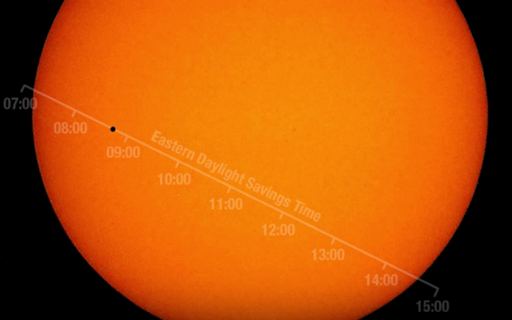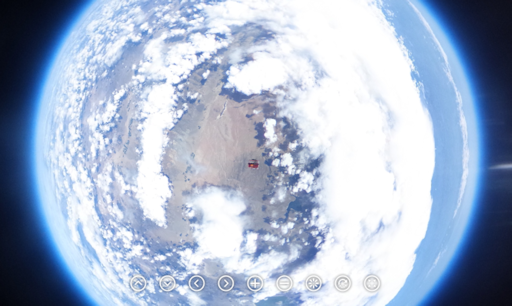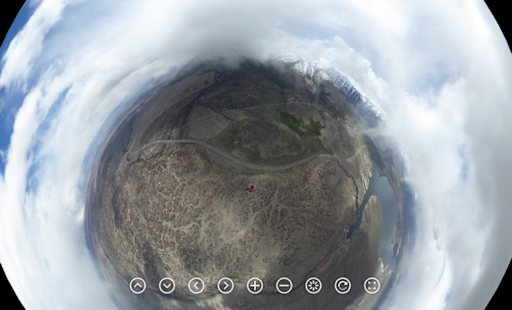On May 9th, the planet Mercury will pass in front of the sun, producing an inky-black spot on the solar disk. Catch it live on the Internet, courtesy of the Coca-Cola Space Science Center in Columbus, Georgia. | | | MINOR GEOMAGNETIC STORM: A minor G1-class geomagnetic storm is underway on May 6th as Earth enters a high-speed stream of solar wind. NOAA forecasters say there is a 35% chance that intermittent storminess could continue through May 7th as the solar wind continues to blow. Aurora alerts: text, voice. TRANSIT OF MERCURY: On Monday morning, May 9th, Mercury will pass directly between Earth and the sun, producing a rare transit visible from the Americas, Europe, Africa and much of Asia. According to NASA, this is what the tiny black disk of the innermost planet will look like as it crosses the solar disk: 
In the USA, the transit begins around 7:15 am eastern time. This means it begins before sunrise on the west coast, but that's no problem. The transit lasts for more than 7 hours, so Mercury will still be gliding across the solar disk when the sun comes up over places like California and Alaska. Everyone in the USA can experience the event. Now for the bad news: Mercury is so small, you can't see the transit with the unaided eye. Safely-filtered solar telescopes are required. Don't have one? In that case, you can watch the transit online, broadcast live from the Coca-Cola Space Science Center in Columbus, Georgia. Also, NASA's Solar Dynamics Observatory will transmit images from space. Mercury passes directly between the sun and Earth about 13 times every century. The last time it happened was ten years ago in 2006, meaning it is more rare than lunar and solar eclipses. If you miss Monday's transit, you'll have to wait until Nov.11, 2019, for the next one. Realtime Space Weather Photo Gallery SPHERICAL CAMERA AT THE EDGE OF SPACE: On May 1st, Spaceweather.com and students of Earth to Sky Calculus launched another space weather balloon to the stratosphere. Onboard was a spherical 360o camera. We've flown this camera before, but this time we flew it upside down. This arrangement afforded a better view of Earth's surface, unobstructed by a thermal pack which keeps the camera warm at the frigid edge of space. Here are the results: 
The interactive image can be spun around and zoomed. Be sure to zoom in on the tiny red box; that's the payload capsule suspended 109,000 feet above Earth's surface. Inside the capsule is an array of X-ray/gamma-ray sensors for monitoring cosmic rays. Regular space weather balloon launches since 2014 have shown that cosmic radiation is intensifying--a trend we are monitoring closely. Spherical images are just icing on the cake of this important scientific research. Bonus: The spherical camera also captured an interesting image en route to the stratosphere. This one shows virga (rain that evaporates before it hits the ground) over Crowley Lake, CA: 
As before, click on the interactive image, then spin it around for the complete spherical experience. Realtime Space Weather Photo Gallery
Realtime Sprite Photo Gallery
Realtime Aurora Photo Gallery
Realtime Comet Photo Gallery Every night, a network of NASA all-sky cameras scans the skies above the United States for meteoritic fireballs. Automated software maintained by NASA's Meteoroid Environment Office calculates their orbits, velocity, penetration depth in Earth's atmosphere and many other characteristics. Daily results are presented here on Spaceweather.com. On May. 6, 2016, the network reported 23 fireballs.
(12 sporadics, 11 eta Aquariids)  In this diagram of the inner solar system, all of the fireball orbits intersect at a single point--Earth. The orbits are color-coded by velocity, from slow (red) to fast (blue). [Larger image] [movies] Potentially Hazardous Asteroids ( PHAs) are space rocks larger than approximately 100m that can come closer to Earth than 0.05 AU. None of the known PHAs is on a collision course with our planet, although astronomers are finding new ones all the time. On May 6, 2016 there were potentially hazardous asteroids. Notes: LD means "Lunar Distance." 1 LD = 384,401 km, the distance between Earth and the Moon. 1 LD also equals 0.00256 AU. MAG is the visual magnitude of the asteroid on the date of closest approach. | | Cosmic Rays in the Atmosphere | | Situation Report -- Oct. 30, 2015 | Stratospheric Radiation (+37o N) | | Cosmic ray levels are elevated (+6.1% above the Space Age median). The trend is flat. Cosmic ray levels have increased +0% in the past month. | | Sept. 06: 4.14 uSv/hr (414 uRad/hr) | | Sept. 12: 4.09 uSv/hr (409 uRad/hr) | | Sept. 23: 4.12 uSv/hr (412 uRad/hr) | | Sept. 25: 4.16 uSv/hr (416 uRad/hr) | | Sept. 27: 4.13 uSv/hr (413 uRad/hr) | | Oct. 11: 4.02 uSv/hr (402 uRad/hr) | | Oct. 22: 4.11 uSv/hr (411 uRad/hr) | These measurements are based on regular space weather balloon flights: learn more. Approximately once a week, Spaceweather.com and the students of Earth to Sky Calculus fly "space weather balloons" to the stratosphere over California. These balloons are equipped with radiation sensors that detect cosmic rays, a surprisingly "down to Earth" form of space weather. Cosmic rays can seed clouds, trigger lightning, and penetrate commercial airplanes. Our measurements show that someone flying back and forth across the continental USA, just once, can absorb as much ionizing radiation as 2 to 5 dental X-rays. For example, here is the data from a flight on Oct. 22, 2015: 
Radiation levels peak at the entrance to the stratosphere in a broad region called the "Pfotzer Maximum." This peak is named after physicist George Pfotzer who discovered it using balloons and Geiger tubes in the 1930s. Radiation levels there are more than 80x sea level. Note that the bottom of the Pfotzer Maximim is near 55,000 ft. This means that some high-flying aircraft are not far from the zone of maximum radiation. Indeed, according to the Oct 22th measurements, a plane flying at 45,000 feet is exposed to 2.79 uSv/hr. At that rate, a passenger would absorb about one dental X-ray's worth of radiation in about 5 hours. The radiation sensors onboard our helium balloons detect X-rays and gamma-rays in the energy range 10 keV to 20 MeV. These energies span the range of medical X-ray machines and airport security scanners. | | The official U.S. government space weather bureau | | | The first place to look for information about sundogs, pillars, rainbows and related phenomena. | | | Researchers call it a "Hubble for the sun." SDO is the most advanced solar observatory ever. | | | 3D views of the sun from NASA's Solar and Terrestrial Relations Observatory | | | Realtime and archival images of the Sun from SOHO. | | | from the NOAA Space Environment Center | | | the underlying science of space weather | | 
